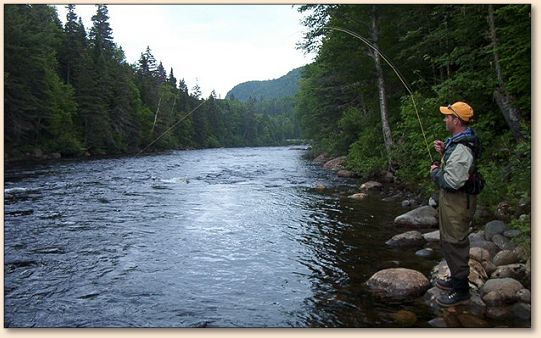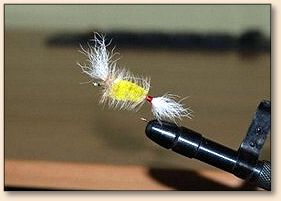From the Tying Bench
By Chris Chin
The Salmon season in Quebec is relatively short. When I
exchange with friends from all over the world, they are just
flabbergasted that we don't have any fishing throughout the
winter. Well, it does give me some time to tie up some flies!
I'm not a commercial Tyer. I don't follow a lot of the good
habit rules for effective fly tying. Instead of laying out the
materials for one or two flies and running off a batch, I'll
often tie 5-6 different flies in the same sitting. Within a matter
of minutes, there are dozens of various materials, capes,
bobbins etc strewn about the table.
Then again, I prefer to daydream while I'm tying. I usually tie
a specific fly for a specific situation and very often for a specific
pool.
I pull a model out of the vest. An old stand by for hot and
sunny August days on my home waters. As I rummage
around in my (meagre) tying kit, I get whisked back to
the river a decade ago.
My clients very taking a nap at mid day, resting up for what
would turn out to be a dream-come-true evening on another
run. I decided to scout out a pool for a group that would be
coming over the next day.
The sun was high in the sky and warm showers had been
coming and going all morning long. The water level has been
stable. It takes about 8 hours for the first influx of water to
run out of the Valin Mountains and into the main branch of
the river. I set up on Glass pool to see if I can get one of the
monsters to rise to a dry fly.
Glass Pool is a "Famous" pool here in Quebec. A long series
of rapids and runs come up through the valley. Suddenly, the
river bed spreads out to form a large, deep back eddy. At the
same time, cooler water flows in from the Murailles Arm of the
river. A perfect holding and resting pool for migrating salmon.
Further, there is a spawning bed not "too" far upstream (in a
not to be undisclosed location), so many salmon come up and
hold here for the rest of the season.

A look out onto Glass Pool from the observation deck
Looking downstream from Glass Pool. The run continues downstream
of over 3 miles (Oh, and Andre Marceau in the foreground — connected
to the Salmon of his life!)

Casting from the Warden's side of the pool is an up and across
affair. (That is, from the downstream side of the pool where the
Head Warden spends the season). Dry fly territory!
With the sun overhead, I usually opt for a smaller profile fly
in light or pale colors.

A smaller dry fly for here. The red floss is just so that I know it's one of mine
There had been some anglers here very early in the morning.
However, with the low overcast sky that morning, the salmon
were well and solidly bottom hugging. Now, with the sky open
and the sun streaming down, the big adults were starting to look up.
I only wanted to try for one particular salmon, so I set up out in
the current and striped out a short length fly line. Holding two feet
upstream from the "big rock," a monster had been angled slightly
nose down there for the past four days. Now, with the impending
water level rise, she was hovering four feet deep, four feet off of
the bottom!
I cast up and out. The fly lands nicely with a slight "poof" just a few
feet up from the big Hen. Nothing. I let the fly drift out, but recover
it before it drifts over the males and Grisles holding ten feet downstream
(I'm saving them for tomorrow's Clients). From where I'm standing, the
fly "appears" to be long. One has to remember though, that the fish
is holding down a certain distance from the surface. The parallax will
make it "look" like it is drifting over the fish, when in reality, it is short.
Another cast, two feet upstream. Nothing still. I decide to quarter
the salmon.
I drop successive presentations two feet upstream, two feet on either
side and also one foot behind the salmon. Each cast is presented for
1-2 seconds, then lifted off of the surface. It helps to use some sort
of wiggle, coil or rolled pickup to slightly lessen the surface disturbance,
but that too is part of the technique.
Apparently, this is called running the clock. I keep this up for a
dozen casts and then cast one final time three feet upstream of
her. I let the fly sit there. The Hen, properly distraught by all the
disturbance on and around her seems to decide that this is enough.
In a heartbeat she slices up through the water column, breaches
the surface in a nose, dorsal then tail combination and dives away.
The fly is gone!
Classic technique for Atlantic salmon says to count to three or say
in your head "God save the Queen" before setting the hook. In my
case, in the time I say in my head "Holy CRAP, … she took
the fly!" I start to lift the rod and strike with my stripping hand.
From this casting position, things get real complicated really fast.
The salmon, once hooked will do 1 of two things. If she runs left
(upstream) into the pool, there's no problem, as she'll pull out line
all the way (and this rarely happens). Conversely, if they run
downstream, they go PAST the angler on their way towards
another postal code. I furiously reel in line as she sails past in
an attempt to return to the Atlantic Ocean!
Once past me, line starts un-reeling as she gets down into the
current. Hopefully she will stop before she gets to the rapids
(600 feet away!) Luckily, she DOES stop just over the lip of
a small drop and she holds head down in the pot.
The water is fairly warm (over 55 degrees) so I don't want to
prolong this too much. I lean back deeply against the rod and
slowly walk my way back towards the rocky shore. Slowly,
she comes up over the lip. Once back on the run, she decides
to move back to her holding lie. I keep back peddling to the
shore and recuperate line before she gets to right angles with
me. I want to get rod pressure back on her when she is across
from me. That way, I won't pull out. Also, if I pull on her once
she's "upstream" from me, I'll make her want turn and she'll return
to the pot.
Pulling straight across from her, she slowly meanders across
the current. No leaps or spectacular splashes, she is too smart
to waste her energy reserves. Fifteen minutes after the take and
she is close to hand. A few cat and mouse ten yard sprints and
she is at my feet.
I get a five second good look when I tail her and pop out the barbless hook.
I love this Sport! ~ Christopher Chin, Three Rivers Quebec.
About Chris:
Chris Chin is originally from Kamloops,
British Columbia. He has been fly fishing
on and off ever since he was 10 years old.
Chris became serious about the sport within
the last 10 years.
"I'm a forest engineer by day and part time
guide on the Ste-Marguerite River here in
central Quebec. I've been fishing this river
for about 10 years now and started guiding
about 5 years ago when the local guide's
association sort of stopped functioning."
Chris guides mostly for sea run brook trout
and about 30% of the time for Atlantic Salmon.
"I often don't even charge service fees, as
I'm more interested in promoting the river
than making cash. I like to get new comers
to realize that salmon fishing is REALLY for
anyone who cares to try it. Tradition around
here makes some of the old clan see Salmon
fishing as a sport for the rich. Today our
shore lunches are less on the cucumber sandwich
side and more toward chicken pot pie and Jack
Daniel's."
Chris is 44 years old as of this writing. He
is of Chinese origin although his parents were
born and raised in Jamaica.
To learn more about the Ste-Marguerite River,
visit Christopher's
website. You can email Chis at: Flyfishing.christopher@gmail.com.
Our Man In Canada Archives
|

